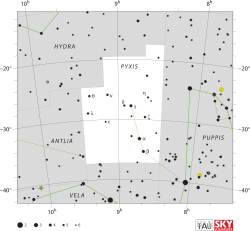| Observation data Epoch J2000.0 Equinox J2000.0 (ICRS) | |
|---|---|
| Constellation | Pyxis |
| Right ascension | 09h 09m 56.41024s[1] |
| Declination | −30° 21′ 55.4460″[1] |
| Apparent magnitude (V) | +5.60[2] |
| Characteristics | |
| Spectral type | A4 IV[3] |
| U−B color index | +0.16[2] |
| B−V color index | +0.16[2] |
| Astrometry | |
| Radial velocity (Rv) | −9.7±0.3[4] km/s |
| Proper motion (μ) | RA: −1.93[1] mas/yr Dec.: −48.99[1] mas/yr |
| Parallax (π) | 15.39 ± 0.30 mas[1] |
| Distance | 212 ± 4 ly (65 ± 1 pc) |
| Absolute magnitude (MV) | +2.00[5] |
| Details | |
| ε Pyx A | |
| Mass | 2.07[6] M☉ |
| Luminosity | 19[7] L☉ |
| Surface gravity (log g) | 3.26[8] cgs |
| Temperature | 6368±1806[8] K |
| Metallicity [Fe/H] | +0.04[8] dex |
| Rotational velocity (v sin i) | 108.3±0.3[9] km/s |
| Age | 560[6] Myr |
| Other designations | |
| Database references | |
| SIMBAD | data |
Epsilon Pyxidis (ε Pyxidis) is quadruple[11] star system in the southern constellation of Pyxis. It is faintly visible to the naked eye, having a combined apparent visual magnitude of +5.60.[2] Based upon an annual parallax shift of 15.39 mas as seen from Earth,[1] it is located around 212 light years from the Sun. The system is deemed to be a member of the Sirius supercluster of stars that share a common motion through space.[5]
The primary, component A, is a white-hued A-type subgiant star with a stellar classification of A4 IV.[3] It is a microvariable, showing a 0.0056 change in magnitude with a frequency of 0.16245 times per day.[12] Epsilon Pyxidis has been catalogued as an Am star,[2] although this remains uncertain.[13] It has double[6] the mass of the Sun and radiates 19[7] times the Sun's luminosity from its photosphere at an effective temperature of 6,368 K.[8]
In addition to a close companion of unknown type at an angular separation of 0.17 arc seconds, the primary shares an orbit with a binary star system, components B and C, that lie at an angular separation of 17.8 arc seconds. At the estimated distance of this system, this corresponds to a projected separation of around 1,150 AU.[6] The B/C pair consist of visual magnitude 10.5 and 10.8 stars with a mean separation of 0.3 arc seconds.[11] They have estimated mass of 90% and 95% that of the Sun, respectively.[6]
- ^ a b c d e f Cite error: The named reference
vanLeeuwen2007was invoked but never defined (see the help page). - ^ a b c d e Cite error: The named reference
Mendoza1978was invoked but never defined (see the help page). - ^ a b Cite error: The named reference
houk1979was invoked but never defined (see the help page). - ^ Cite error: The named reference
deBruijne2012was invoked but never defined (see the help page). - ^ a b Cite error: The named reference
Eggen1998was invoked but never defined (see the help page). - ^ a b c d e Cite error: The named reference
DeRosa2014was invoked but never defined (see the help page). - ^ a b Cite error: The named reference
Mcdonald2012was invoked but never defined (see the help page). - ^ a b c d Cite error: The named reference
Casagrande2011was invoked but never defined (see the help page). - ^ Cite error: The named reference
Diaz2011was invoked but never defined (see the help page). - ^ Cite error: The named reference
SIMBADwas invoked but never defined (see the help page). - ^ a b Cite error: The named reference
Eggleton2008was invoked but never defined (see the help page). - ^ Cite error: The named reference
koen2002was invoked but never defined (see the help page). - ^ Cite error: The named reference
Renson2009was invoked but never defined (see the help page).
